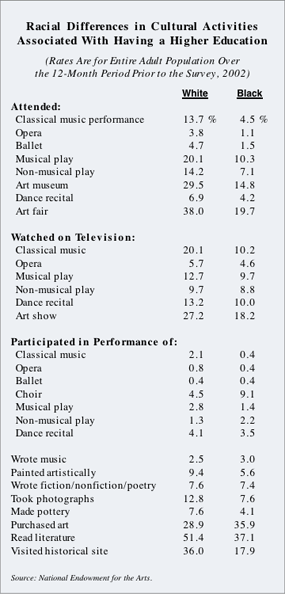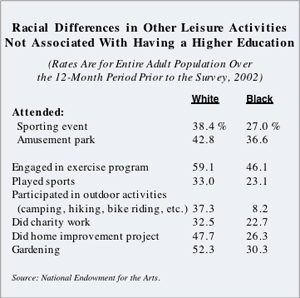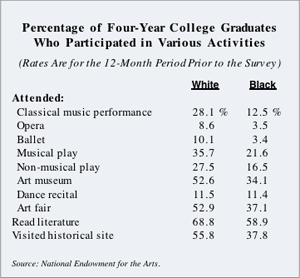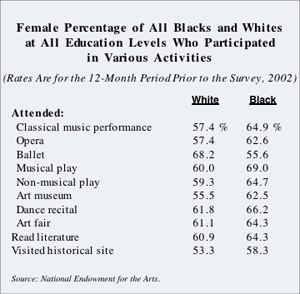| The Black-White Divide in Cultural Pursuits Blacks are generally less likely than whites to attend or participate in cultural activities such as the theater, opera, art, or ballet. The higher education gap between the races explains some of the differences. But even among blacks and whites with a college education, a significant cultural gap exists.
In view of the racial disparity in college completions, it is not surprising that whites generally are more likely than blacks to participate in a wide range of cultural activities. These activities include attending the opera, the theater, or an art exhibit. For example, a recent survey conducted by the National Endowment for the Arts found that 85.5 percent of all people who attended a performance of classical music in the year prior to the survey had at least some college experience. Over 60 percent of the people attending ballet performances were four-year college graduates. Nearly 30 percent of people who attended the opera have at least one graduate degree. The published survey by the National Endowment for the Arts compared the rates of attendance and participation in various cultural activities for blacks and whites. In almost all cases, whites were more likely than blacks to attend or participate in these types of events. In many cases, the differences were large. For example, whites were three times as likely as blacks to attend a classical music performance, the opera, or the ballet. Whites were twice as likely as blacks to attend a musical play or other type of theatrical production. Whites were also twice as likely as blacks to go to an art fair. Whites were also significantly more likely than blacks to attend a dance recital or an art museum. The cost of attending these events is undoubtedly one reason for the racial gap in attendance. Tickets to many of these performances are very expensive, and since black families have a median income that is only 60 percent of the median income of white families, it is undoubtedly difficult for many black families to afford the price of attendance.
But money is not the only reason for the cultural gap. This is demonstrated by National Endowment for the Arts data on people who watch these types of cultural events on television. Here, blacks and whites have roughly equal access to the performing arts. And the racial gaps are considerably smaller. But whites are still more likely than blacks to watch classical music performances, plays, ballet, and dance on television.
Participation in Cultural Events In addition to attending or watching performances of cultural events, the racial gap extends to participation in the arts. Whites are five times as likely as blacks to be involved in the performance of classical music. Whites are twice as likely as blacks to sing opera or to act in a musical play. But blacks hold the lead in involvement in non-musical plays. Whites and blacks were equally likely to perform ballet. Blacks hold a significant lead over whites in participation in a choir or choral group. Undoubtedly, this is due to the large numbers of African Americans who sing in their church choirs. The National Endowment for the Arts survey also included data on other activities generally believed to be associated with people who have experience in higher education. Whites are more likely than blacks to paint artistically, participate in photography, or to make pottery. Whites are also more likely than blacks to visit historical sites or read works of literature. Blacks are more likely than whites to compose music and to purchase art.
Racial Cultural Gap Prevails for College Graduates
But the newly mined data shows that even for college graduates, there remains a significant racial gap in participation in these cultural activities. White college graduates are more than twice as likely as African-American college graduates to attend a classical music performance or the opera. The racial gap in attendance at the ballet is even wider. White college graduates are more than three times as likely as blacks with the same level of education to attend the ballet. White college graduates were also more likely than similarly educated blacks to attend the theater, an art museum, or art fairs. Whites are also more likely to visit historical sites or to read literature. The one exception is that there are very similar rates between blacks and whites in attendance of dance recitals.
The Gender Gap in Attending Cultural Events
More than 64 percent of all blacks who attended classical music performances, musical and non-musical plays, dance recitals, and art fairs are women. In each case this is significantly larger than the female percentage of all whites who attend these events. The only cultural event where the percentage of women attendees is greater for whites than it is for blacks is the ballet. |
|




 As we report on page 16 of this issue of JBHE, 18.5 percent of all black adults over the age of 25 now have a four-year college degree. In contrast, 31.8 percent of white adults have earned a bachelor’s degree.
As we report on page 16 of this issue of JBHE, 18.5 percent of all black adults over the age of 25 now have a four-year college degree. In contrast, 31.8 percent of white adults have earned a bachelor’s degree.  The role of money in attending or participating in cultural events can be seen in data for other leisure activities not generally associated exclusively with people who have a higher education. For example, whites are more likely than blacks to attend a sporting event or an amusement park. Whites are also more likely to garden and do home improvement projects. Money is undoubtedly the major reason for these racial differences.
The role of money in attending or participating in cultural events can be seen in data for other leisure activities not generally associated exclusively with people who have a higher education. For example, whites are more likely than blacks to attend a sporting event or an amusement park. Whites are also more likely to garden and do home improvement projects. Money is undoubtedly the major reason for these racial differences. The report from the National Endowment for the Arts did not break down the data by gender or education level. But statisticians at the organization provided JBHE access to their computer database. Generally for both blacks and whites, college graduates are far more likely than the population as a whole to participate in cultural events.
The report from the National Endowment for the Arts did not break down the data by gender or education level. But statisticians at the organization provided JBHE access to their computer database. Generally for both blacks and whites, college graduates are far more likely than the population as a whole to participate in cultural events. Women of all races are more likely than men to attend cultural events such as the ballet or a performance of a symphony orchestra. But gender differences are far more pronounced among African Americans than for whites. Clearly, this is because nearly two thirds of all blacks who now earn bachelor’s degrees are women. And, as stated before, college graduates are far more likely to attend these types of events than are people with a lower level of education.
Women of all races are more likely than men to attend cultural events such as the ballet or a performance of a symphony orchestra. But gender differences are far more pronounced among African Americans than for whites. Clearly, this is because nearly two thirds of all blacks who now earn bachelor’s degrees are women. And, as stated before, college graduates are far more likely to attend these types of events than are people with a lower level of education.